+ データを開く
データを開く
- 基本情報
基本情報
| 登録情報 | データベース: PDB / ID: 3j7g | ||||||
|---|---|---|---|---|---|---|---|
| タイトル | Electron cryo-microscopy of human papillomavirus 16 and H16.V5 Fab fragments | ||||||
 要素 要素 | L1 | ||||||
 キーワード キーワード | VIRUS / pentamer of human papillomavirus / QV16-V5 complex / virus-Fab complex / neutralization antibody / maturation | ||||||
| 機能・相同性 |  機能・相同性情報 機能・相同性情報T=7 icosahedral viral capsid / endocytosis involved in viral entry into host cell / virion attachment to host cell / host cell nucleus / structural molecule activity 類似検索 - 分子機能 | ||||||
| 生物種 |  Human papillomavirus type 16 (パピローマウイルス) Human papillomavirus type 16 (パピローマウイルス) | ||||||
| 手法 | 電子顕微鏡法 / 単粒子再構成法 / クライオ電子顕微鏡法 / 解像度: 13.6 Å | ||||||
 データ登録者 データ登録者 | Lee, H. / Hafenstein, S. | ||||||
 引用 引用 |  ジャーナル: J Virol / 年: 2015 ジャーナル: J Virol / 年: 2015タイトル: A cryo-electron microscopy study identifies the complete H16.V5 epitope and reveals global conformational changes initiated by binding of the neutralizing antibody fragment. 著者: Hyunwook Lee / Sarah A Brendle / Stephanie M Bywaters / Jian Guan / Robert E Ashley / Joshua D Yoder / Alexander M Makhov / James F Conway / Neil D Christensen / Susan Hafenstein /  要旨: Human papillomavirus 16 (HPV16) is a worldwide health threat and an etiologic agent of cervical cancer. To understand the antigenic properties of HPV16, we pursued a structural study to elucidate HPV ...Human papillomavirus 16 (HPV16) is a worldwide health threat and an etiologic agent of cervical cancer. To understand the antigenic properties of HPV16, we pursued a structural study to elucidate HPV capsids and antibody interactions. The cryo-electron microscopy (cryo-EM) structures of a mature HPV16 particle and an altered capsid particle were solved individually and as complexes with fragment of antibody (Fab) from the neutralizing antibody H16.V5. Fitted crystal structures provided a pseudoatomic model of the virus-Fab complex, which identified a precise footprint of H16.V5, including previously unrecognized residues. The altered-capsid-Fab complex map showed that binding of the Fab induced significant conformational changes that were not seen in the altered-capsid structure alone. These changes included more ordered surface loops, consolidated so-called "invading-arm" structures, and tighter intercapsomeric connections at the capsid floor. The H16.V5 Fab preferentially bound hexavalent capsomers likely with a stabilizing effect that directly correlated with the number of bound Fabs. Additional cryo-EM reconstructions of the virus-Fab complex for different incubation times and structural analysis provide a model for a hyperstabilization of the capsomer by H16.V5 Fab and showed that the Fab distinguishes subtle differences between antigenic sites. IMPORTANCE: Our analysis of the cryo-EM reconstructions of the HPV16 capsids and virus-Fab complexes has identified the entire HPV.V5 conformational epitope and demonstrated a detailed neutralization ...IMPORTANCE: Our analysis of the cryo-EM reconstructions of the HPV16 capsids and virus-Fab complexes has identified the entire HPV.V5 conformational epitope and demonstrated a detailed neutralization mechanism of this clinically important monoclonal antibody against HPV16. The Fab bound and ordered the apical loops of HPV16. This conformational change was transmitted to the lower region of the capsomer, resulting in enhanced intercapsomeric interactions evidenced by the more ordered capsid floor and "invading-arm" structures. This study advances the understanding of the neutralization mechanism used by H16.V5. | ||||||
| 履歴 |
|
- 構造の表示
構造の表示
| ムービー |
 ムービービューア ムービービューア |
|---|---|
| 構造ビューア | 分子:  Molmil Molmil Jmol/JSmol Jmol/JSmol |
- ダウンロードとリンク
ダウンロードとリンク
- ダウンロード
ダウンロード
| PDBx/mmCIF形式 |  3j7g.cif.gz 3j7g.cif.gz | 411 KB | 表示 |  PDBx/mmCIF形式 PDBx/mmCIF形式 |
|---|---|---|---|---|
| PDB形式 |  pdb3j7g.ent.gz pdb3j7g.ent.gz | 338.7 KB | 表示 |  PDB形式 PDB形式 |
| PDBx/mmJSON形式 |  3j7g.json.gz 3j7g.json.gz | ツリー表示 |  PDBx/mmJSON形式 PDBx/mmJSON形式 | |
| その他 |  その他のダウンロード その他のダウンロード |
-検証レポート
| 文書・要旨 |  3j7g_validation.pdf.gz 3j7g_validation.pdf.gz | 897.7 KB | 表示 |  wwPDB検証レポート wwPDB検証レポート |
|---|---|---|---|---|
| 文書・詳細版 |  3j7g_full_validation.pdf.gz 3j7g_full_validation.pdf.gz | 964.2 KB | 表示 | |
| XML形式データ |  3j7g_validation.xml.gz 3j7g_validation.xml.gz | 65.3 KB | 表示 | |
| CIF形式データ |  3j7g_validation.cif.gz 3j7g_validation.cif.gz | 97.7 KB | 表示 | |
| アーカイブディレクトリ |  https://data.pdbj.org/pub/pdb/validation_reports/j7/3j7g https://data.pdbj.org/pub/pdb/validation_reports/j7/3j7g ftp://data.pdbj.org/pub/pdb/validation_reports/j7/3j7g ftp://data.pdbj.org/pub/pdb/validation_reports/j7/3j7g | HTTPS FTP |
-関連構造データ
- リンク
リンク
- 集合体
集合体
| 登録構造単位 | 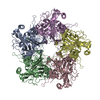
|
|---|---|
| 1 | x 60
|
| 2 |
|
| 3 | x 5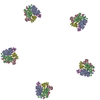
|
| 4 | x 6
|
| 5 | 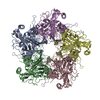
|
| 対称性 | 点対称性: (シェーンフリース記号: I (正20面体型対称)) |
- 要素
要素
| #1: タンパク質 | 分子量: 50873.422 Da / 分子数: 5 / 断片: UNP residues 47-500 / 由来タイプ: 天然 由来: (天然)  Human papillomavirus type 16 (パピローマウイルス) Human papillomavirus type 16 (パピローマウイルス)参照: UniProt: Q4VRM0, UniProt: P03101*PLUS |
|---|
-実験情報
-実験
| 実験 | 手法: 電子顕微鏡法 |
|---|---|
| EM実験 | 試料の集合状態: PARTICLE / 3次元再構成法: 単粒子再構成法 |
- 試料調製
試料調製
| 構成要素 |
| ||||||||||||||||||||
|---|---|---|---|---|---|---|---|---|---|---|---|---|---|---|---|---|---|---|---|---|---|
| 分子量 | 値: 42 MDa / 実験値: NO | ||||||||||||||||||||
| ウイルスについての詳細 | 中空か: NO / エンベロープを持つか: NO / ホストのカテゴリ: VERTEBRATES / 単離: OTHER / タイプ: VIRION | ||||||||||||||||||||
| 天然宿主 | 生物種: Homo sapiens | ||||||||||||||||||||
| 緩衝液 | 名称: 137 mM NaCl, 2.7 mM KCl, 10 mM Na2HPO4, 1.8 mM KH2PO4 pH: 7.4 詳細: 137 mM NaCl, 2.7 mM KCl, 10 mM Na2HPO4, 1.8 mM KH2PO4 | ||||||||||||||||||||
| 試料 | 濃度: 1 mg/ml / 包埋: NO / シャドウイング: NO / 染色: NO / 凍結: YES | ||||||||||||||||||||
| 試料支持 | 詳細: glow-discharged holey carbon Quantifoil grids | ||||||||||||||||||||
| 急速凍結 | 装置: GATAN CRYOPLUNGE 3 / 凍結剤: ETHANE / Temp: 102 K / 湿度: 90 % 詳細: Blot for 0.7 seconds before plunging into liquid ethane (GATAN CRYOPLUNGE 3). 手法: Blot for 0.7 seconds before plunging |
- 電子顕微鏡撮影
電子顕微鏡撮影
| 顕微鏡 | モデル: JEOL 2100 / 日付: 2013年10月30日 |
|---|---|
| 電子銃 | 電子線源: LAB6 / 加速電圧: 200 kV / 照射モード: SPOT SCAN |
| 電子レンズ | モード: BRIGHT FIELD / 倍率(公称値): 80000 X / 最大 デフォーカス(公称値): 3990 nm / 最小 デフォーカス(公称値): 690 nm / Cs: 2 mm |
| 試料ホルダ | 試料ホルダーモデル: GATAN LIQUID NITROGEN / 温度: 95 K / 傾斜角・最大: 0 ° / 傾斜角・最小: 0 ° |
| 撮影 | 電子線照射量: 15 e/Å2 フィルム・検出器のモデル: GATAN ULTRASCAN 4000 (4k x 4k) |
| 画像スキャン | デジタル画像の数: 411 |
| 放射 | プロトコル: SINGLE WAVELENGTH / 単色(M)・ラウエ(L): M / 散乱光タイプ: x-ray |
| 放射波長 | 相対比: 1 |
- 解析
解析
| EMソフトウェア |
| ||||||||||||||||||||
|---|---|---|---|---|---|---|---|---|---|---|---|---|---|---|---|---|---|---|---|---|---|
| CTF補正 | 詳細: Each particle | ||||||||||||||||||||
| 対称性 | 点対称性: I (正20面体型対称) | ||||||||||||||||||||
| 3次元再構成 | 手法: Cross-common lines / 解像度: 13.6 Å / 解像度の算出法: FSC 0.5 CUT-OFF / 粒子像の数: 2075 / ピクセルサイズ(公称値): 1.48 Å / ピクセルサイズ(実測値): 1.48 Å 詳細: Semi-automatic particle selection was performed using e2boxer.py to obtain the particle coordinates, followed by particle boxing, linearization, normalization, and apodization of the images ...詳細: Semi-automatic particle selection was performed using e2boxer.py to obtain the particle coordinates, followed by particle boxing, linearization, normalization, and apodization of the images using Robem. Defocus and astigmatism values to perform contrast transfer function (CTF) correction were assessed using Robem for the extracted particles. The icosahedrally averaged reconstructions were initiated using a random model generated with setup_rmc and reached 14 A resolution estimated at a Fourier Shell Correlation (FSC) of 0.5. For the last step of refinement, the final maps were CTF-corrected using a B factor of 200 A2. (Single particle--Applied symmetry: I) 対称性のタイプ: POINT | ||||||||||||||||||||
| 原子モデル構築 | プロトコル: FLEXIBLE FIT / 空間: REAL / 詳細: REFINEMENT PROTOCOL--flexible | ||||||||||||||||||||
| 原子モデル構築 | PDB-ID: 3OAE 3oae Accession code: 3OAE / Source name: PDB / タイプ: experimental model | ||||||||||||||||||||
| 精密化ステップ | サイクル: LAST
|
 ムービー
ムービー コントローラー
コントローラー



 UCSF Chimera
UCSF Chimera







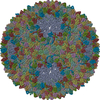
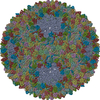


 PDBj
PDBj


